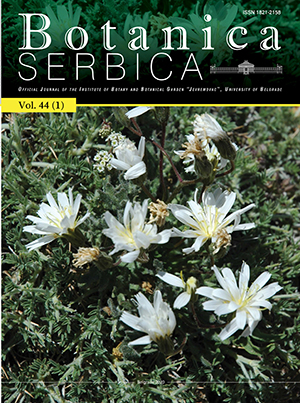
Volume 44 Issue 1 2020 |
First finding of a genus Haslea Simonsen in Serbia and new diatom taxa for the country's flora in extreme and unique habitats in the Vojvodina Province
|
KEY WORDS: halophilic species, Haslea spicula, saline habitats |
Cohabitant charophyte algal flora and its ecology in high-mountain lakes of
the Artabel Lakes Nature Park (Gümüşhane, Turkey)
|
KEY WORDS: Artabel Lakes Nature Park, high-mountain lakes, Charophyta, Turkey |
Effects of salt on selected bryophyte species tested under controlled conditions
|
KEY WORDS: salt stress, mosses, Entosthodon hungaricus, Hennediella heimii, Physcomitrella patens |
Micromorphology of an involucral bract and cypselae of the endemic and relict species Amphoricarpos elegans Albov (Asteraceae, Cardueae) from the Caucasus
|
KEY WORDS: dimorphic cypselae, SEM, Xerantheminae |
Contribution to knowledge about genome size in members of the family Asteraceae from Turkey: first assessments in 17 taxa, with chromosome counts for nine taxa
|
KEY WORDS: Achillea, Anthemis, Compositae, Crepis, flow cytometry, Tanacetum |
Pollen of Arbutus unedo: Effects of plant growth regulators
|
KEY WORDS: anther, epibrassinolide, flower, gibberellin, strawberry tree |
Anatomy, chlorophyll content and photosynthetic performance in current-year and previous-year Aleppo pine (Pinus halepensis Mill.) needles
|
KEY WORDS: Aleppo pine, chlorophyll a fluorescence, needle anatomy, needle development, Pinus halepensis, photosynthesis |
Chemical composition of the essential oil of Salvia bracteata Banks and the biological activity of its extracts: antioxidant, total phenolic, total flavonoid, antifungal and allelopathic effects
|
KEY WORDS: Salvia bracteata, antioxidant activity, total phenolic, flavonoid, antifungal and allelopathic effects |
New records and noteworthy data of plants, algae and fungi in SE Europe and adjacent regions, 1
|
KEY WORDS: new record, Allium atropurpureum, Allosorus persicus, Arthrocladiella mougeotii, Calluna vulgaris, Campylopus fragilis, Campylopus introflexus, Riccia frostii, Santolina chamaecyparissus, Sisyrinchium montanum, Tomentypnum nitens |
New reports of Melampsora rust (Pucciniomycetes) on the Salix retusa complex in Balkan countries
|
KEY WORDS: plant pathogen, distribution, Melampsora epitea, basidiomycete, snow willows |
New floristic and syntaxonomic data from rice fields in Bulgaria
|
KEY WORDS: oryzicolous flora and vegetation, weeds, Oryzetea sativae |
List of reviewers for Botanica Serbica in 2019 — Acknowledgements
|


